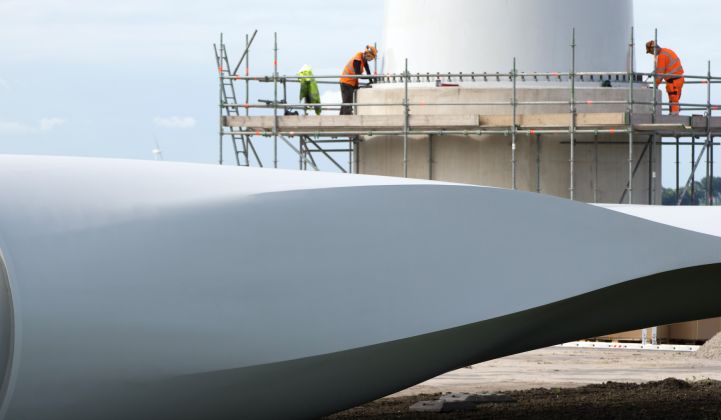Like many Americans, I am an avid listener to American Public Media’s program Marketplace. The show bills itself as "the most widely heard program on business and the economy -- radio or television, commercial or public broadcasting -- in the country." That popularity can also be a problem when journalists on the show discuss something they don't understand.
Earlier this month, Marketplace had a weekly roundup on the economy, focusing on manufacturing jobs because of emphasis provided on this topic by both of the presidential campaigns. The guests were John Carney of The Wall Street Journal and Catherine Rampell from the Washington Post.
At the third minute, Rampell weighs in on whether clean energy jobs would really help laid-off manufacturing workers. At 4:30, Carney shows his complete ignorance and claims that clean energy jobs are “science fiction."
I know that Marketplace knows better. Scott Tong does excellent clean energy reporting for the show on a regular basis.
Let's set the record straight, since Rampell and Carney apparently couldn’t be bothered to perform a basic Google search before the show.
The solar industry alone has created one out of every 80 jobs in the United States since the Great Recession. When including wind, LED lighting, and other clean energy categories, that number could be close to one in 33.
For the solar industry, a majority of these new employment opportunities are blue-collar construction and manufacturing jobs that pay an average of $21 per hour -- far higher than the $16 per hour non-union manufacturing jobs that South Carolina was touting later in that episode.
Remarkably, even Kai Ryssdal got into the bashing by questioning if clean energy could make a dent in hiring laid-off manufacturing and mining workers.
In fact, the solar industry has hired more veterans than anyone else, retrained coal workers, and even provided a soft landing for oil and gas workers who have lost their jobs. The vast majority of solar and wind workers are trained in less than six months because their previous work experience and training is completely transferrable.
According to the U.S. Bureau of Labor Statistics, "wind technician" is the fastest-growing job category -- expanding twice as much as the next-fastest growing job, occupational therapy assistant.
In 2015, the manufacturing arms of the solar and wind industries employed tens of thousands of people making pieces and parts in the United States. This is up by 20,000 people over 2014. In fact, this number is expected to continue to grow at that pace for the next five years.
How does an amazing show like Marketplace get these things so wrong? How do folks from the Washington Post and The Wall Street Journal not know that solar and wind power now make up over 75 percent of new electric capacity additions in the United States -- representing over $70 billion in new capital investment in 2016 alone? In so doing, these industries are generating substantial fees for investment banks, lawyers, accountants, and often advertising dollars for their newspapers and radio shows.
My sense is that these folks want to run as far away from environmentalists as possible. Clean energy in the United States has been defined by earnest environmentalists who, to their credit, embraced it wholeheartedly. But to our collective detriment, they spun an ideological, naive story divorced from the reality of the energy economy transformation actually taking shape around us.
The result is that clean energy is mistakenly seen as a passive and precious solution for a future society -- a delicate sunflower waving in the face of a muscular coal miner or a pristine field of green and sky of blue set against a dirt mound penetrated by a fracking rig. It feels more utopian than aspirational, more luxury than necessity.
In short, it doesn’t feel American.
American is can-do, right-now, yes ma’am. Luckily, the actual transformation of the energy economy is as American as the Hoover Dam or the interstate highways, and even more earth-shaking. If only the discussion among politicians, media, business leaders, and the American public reflected that reality.
Unfortunately, the clean energy conversation is profoundly and unnecessarily polarizing. Like climate change itself, it’s become part of a larger culture war that fits neatly into the media’s predictable tendency of constructing false equivalences, pitting workers against activists, businesspeople against academics, and common sense against idealism. As a result, according to recent surveys, public sentiment about the urgency of action to prevent climate change is split along party lines between “Let's do something!” and “Meh.”
The energy might be clean, but the work and the jobs are as rooted in dirt, sweat and back-breaking labor as any American endeavor, and even more lasting.
We need to change the conversation to align with the deep emotional and aspirational narratives that speak to the American public. Clean energy could feel as all-American, cutting-edge, rugged, reliable, resilient and tough as fracking. The same American ideals of independence, freedom, self-sufficiency and opportunity can bring together green advocates and tea-party stalwarts, labor and entrepreneurs, Main Street and Wall Street.
Independence is the heart of American identity. Clean energy is independence turned into electrons: the application of cunning, sweat and ingenuity to harness the restless power of the American landscape.
The American energy economy is changing, and changing rapidly. Clean energy and energy efficiency are where the growth is happening. We can move of millions people from coal mining, low-tech manufacturing, and even oil and gas into well-paying jobs that don’t negatively impact the health of people and the planet.
By rebranding clean energy, we can empower all Americans to work together for a stronger future. It’s time to get down and dirty.
***
Jigar Shah is the president of Generate Capital and a co-host of GTM's Energy Gang podcast. This piece was originally published at LinkedIn.
Listen to Jigar discuss the piece in this week's podcast, starting at 30:55.



